What is plywood cost?
Plywood cost is the full money you pay to use one sheet or one cubic meter. It starts at the mill gate. Then adds trim loss, quality risk, and freight. Also, It may add storage, finance, and claims. We link price to value and to yield. Grade, core, glue, thickness, and size move the base. Origin, season, and fuel push the add-ons. A smart buyer tracks both parts. You pick the right spec for the job. Tune the packing and the route. You follow clear checks at the mill. Then the number you budget is the number you hit.
Plywood cost factors you can control
You control many drivers. Pick grade, core, and glue. Set plywood size and thickness. You choose mill direct or a dealer. PLan the load mix. You also control QC steps. Each choice moves the final bill. Small tweaks save big money. Start with the bill of material. Then match spec to real need. Avoid over spec. Avoid under spec. Tie checks to each step. Lock the gain.
Quick wins
Choose the right grade for each face.
Match glue class to the site.
Plan mixed thickness by layer.
Batch sizes for full container use.
Tighten moisture and flatness checks.
Ship with corner and edge guards.
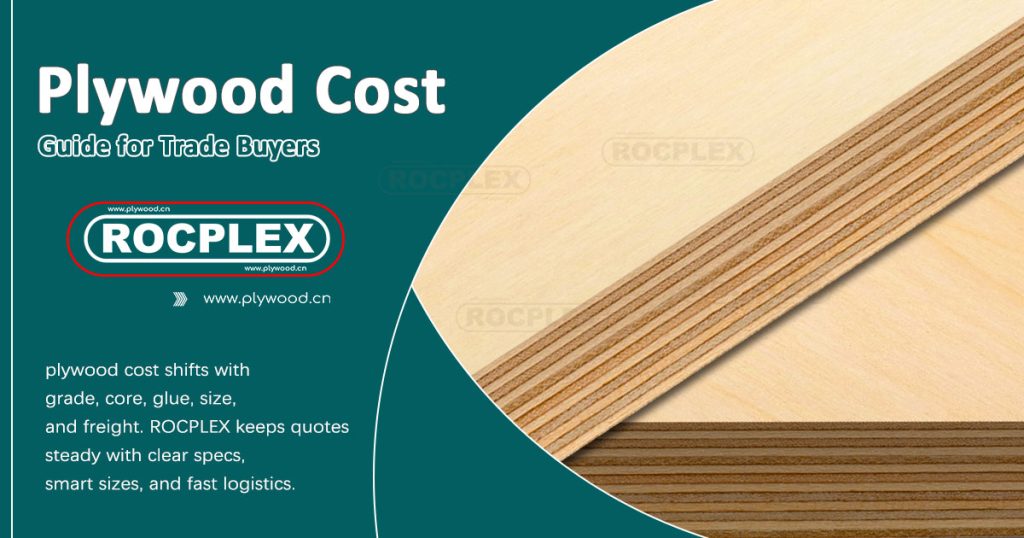
Grade and face veneer impact
Face grade drives price and look. A face with few patches costs more. A clear face helps paint and print. Yet many jobs do not need it. Interior backs can drop one grade. That saves money with no risk. Use putty rules that fit the use. Save the top grade for key faces. Mark the pallet by grade. Your crew loads fast. Your site cuts waste.
Simple rule
Upgrade where it shows. Downgrade where it hides.
Core species and glue affect plywood cost
Core wood sets weight, screw hold, and price. Poplar runs light and smooth. Eucalyptus runs hard and strong. Birch runs stiff and flat. A hybrid core blends traits and cost. Glue matters too. MR suits dry rooms. E1 and E0 cut formaldehyde. WBP holds up in wet formwork. You pay more for higher class glue. But you save on re-use and claims. Pick the lowest class that still meets the job. That choice keeps plywood cost in line.
Thickness and size change plywood cost
Thicker plywood use more wood. They weigh more. They cost more. Big sizes save joins and time. But they raise trim loss. Standard 1220×2440 plywood fit most lines. 1250 widths suit some formwork systems. 915 widths fit light jobs. Run the math for your saw plan. Fewer cuts mean faster builds. Yet offcut waste can hurt. Tune size to the layout. Then plywood cost per square meter drops.
Plywood cost – tolerance, flatness, and rejection risk
Tight tolerance saves rework. It also cuts glue line gaps. Flat sheets speed install. Cup and twist slow crews. You may pay a small premium for tighter control. That premium often beats site waste. Ask for data on thickness spread. Check moisture by pallet. Record panel weight. Track defects by type. Small steps lower your true cost.
Origin and logistics shape total outlay
Origin sets veneer mix and labor. It also sets port fees and lead time. Freight links to route and fuel. Peak season raises rates. Off-peak brings deals. Port rules can add free time or cut it. Detention and demurrage hurt margin. Plan bookings early. Mix thickness for best stow. Use strong dunnage and marks. You then avoid damage claims and delays.
Factory gate vs landed plywood cost
Two numbers matter. Mill price sits at the gate. Landed price sits at your door. The gap holds freight, duty, and port spend. It also holds loss, finance, and stock cost. You win when you see the full chain. Price per CBM means little alone. Tie it to yield and risk. Then the landed plywood cost makes sense.
Checklist for quotes
Incoterm and port pair
Validity in days
Grade and core spec
Glue class and E rating
Thickness and size
Packing and pallet count
QC methods and test plan
Claim terms and cap
Plywood cost -Sheet price vs CBM price
Many markets quote CBM. Some deals quote per sheet. Both work if you convert right. Use this simple math. CBM per sheet = length(m) × width(m) × thickness(m). Sheet price = CBM per sheet × price per CBM. Add packing and inland fees per sheet. Add duty if it applies. Put every add-on in one table. Your team can then compare apples to apples.
Waste, yield, and real job cost
Yield often beats unit price. A cheaper plywood can waste more. Holes, voids, or warp can kill speed. Saw plans also change yield. Plan cuts on a grid. Rotate sheets if that saves joints. Move small parts to offcuts. Label packs by thickness. Keep like sheets together. Crews then pull right the first time. The site stays fast. Your real job cost stays low.
Plywood cost across grades A to D
Grades mark face quality from A to D. A is clean and rare. D shows knots and repairs. Many builds thrive with B/C. Cabinet doors may need B/B. Back faces can step down. In formwork, film faced plywood hide the core. Focus on phenolic film weight and glue class. Match grade to finish target. You cut spend with no loss in use. That is the core idea behind fair plywood cost.
Plywood price signals in the market
Signals help you time buys. Log supply moves with weather. Fuel rates swing with season. Currency shifts hit imports fast. Track these five signs. You then spot turns early.
1) Log harvest reports.
2) Export ban or quota news.
3) Freight index trends.
4) Currency pairs for your route.
5) Mill capacity and downtime.
You do not need to trade. You only need to see the drift. Then you plan one step ahead.
Plywood cost by core and glue class
Core and glue work as a pair. Poplar core lowers weight and price. Birch core raises flatness and hold. Eucalyptus lifts strength. MR glue saves money in dry rooms. E1 and E0 protect indoor air. WBP lifts boil time and re-use. Pick the pair that pays back fast. For furniture backs, save with poplar and E1. Wet decks, move to WBP. For drawers that slide smooth, consider birch. Your plywood cost then fits the job.
Thickness ladders that save budget
You can tune thickness with layers. Mix 9, 12, and 15 mm across the build. Use 18 or 21 mm where spans grow. Drop to 5 or 6 mm for skins. Never overspend for the few heavy spots. Use beams or battens to cut spans. That change often beats thicker plywood. It protects your budget and time.
Simple tools to forecast spend
Use a one-page sheet. List spec, price, yield, and loss. Add freight and duty lines. Add season risk points. Color code must-have traits. Weight each trait from one to five. Total the score. The best value rises fast. You can then lock buys with calm.
ROCPLEX helps you steady plywood cost
ROCPLEX controls veneer at the source. We track log lots by core and face. Dry to tight moisture bands. We press with stable heat and time. We then sand with strict checks. Our teams mark each pallet by spec. Your crews load fast and cut waste. We pack with corner guards and wraps. We share test data for every batch. With that, you plan with real facts. You keep plywood cost steady across months. You also get clear claim terms and fast support.
Why buyers choose ROCPLEX
Stable quality across mills.
FSC and E ratings on file.
Mixed thickness loading plans.
Strong export packing.
Clear, quick paperwork.
Global routes with firm ETAs.
Mill direct Plywood Cost vs distributor
Mill direct cuts one layer of margin. It fits large, steady flows. A distributor adds stock near your site. That saves time on small drops. You can mix both paths. Lock base volumes with the mill. Cover peaks with local stock. You then hold price and speed. Your team never stalls.
Application map: furniture, fit-out, formwork
Furniture needs smooth faces and light cores. Fit-out needs clean edges and paint. Formwork needs strong cores and WBP. Packaging allows lower grade backs. Outdoor signs need weather film. Each use points to a small spec set. Match that set to your build. Then you do not overpay. You also avoid late claims.
People also ask: fast answers buyers need
What makes plywood cost rise fast?
Grade, thickness, glue class, and freight. Currency swings also hit price.
Is plywood cheaper than MDF?
Often not for smooth paint jobs. MDF shines for paint. Plywood wins for screw hold and wet use.
How much is a 4×8 plywood?
It varies by grade and core. Convert CBM to per sheet for clear compare.
What is the best plywood for outdoors?
Use WBP glue and right film. Seal edges and coat fast.
How do I lower cost without risk?
Right spec, tighter QC, and better packing. Plan loads and routes early.
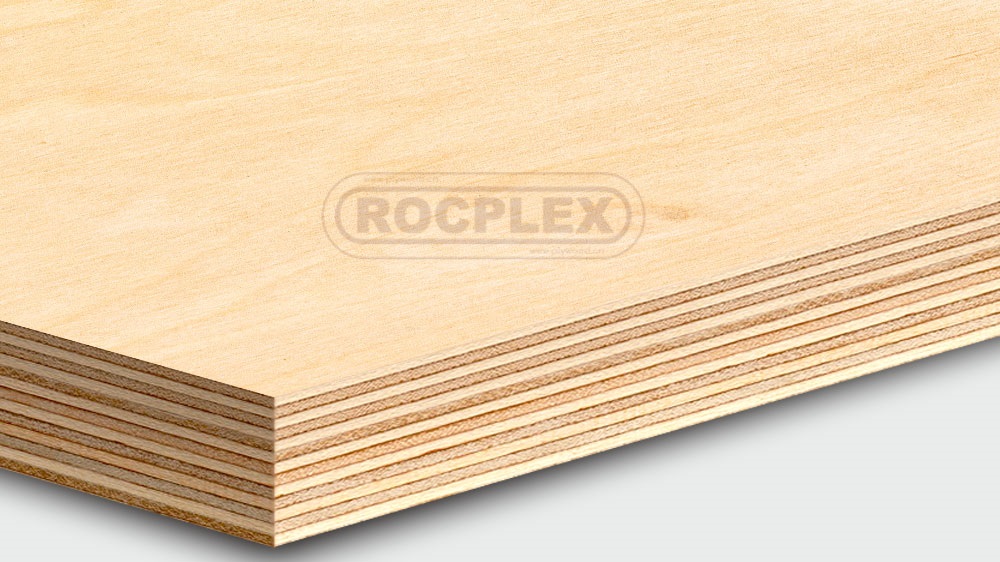
4×8 plywood price vs custom sizes
Standard sizes ship best. They slot well in containers. Custom sizes can cut site waste. They may raise unit price. Balance both. Test a small run of custom sizes on one job. Measure waste and time. If the gain is real, scale up. If not, stay standard. Your budget will thank you.
Bidding math that keeps margins safe
Start with the drawing. Count every face area. Add a clean waste factor. Ten to twelve percent suits most jobs. Convert area to sheets. Then convert sheets to CBM. Use the simple formula you saw. Add freight, duty, packing, and finance. Add the waste cost line. Now add a risk reserve. Two percent covers small claims. Larger projects may need more. Put all lines in one grid. Share the grid with your team. Everyone then prices the same way.
Fast steps
1) Pick the exact spec.
2) Map cuts to each room or bay.
3) Convert to sheets and CBM.
4) Add yield, freight, and risk.
5) Lock the quote window.
Side-by-side: three common specs
Furniture backs (dry rooms).
Poplar core. E1 glue. B/C face. Thin plywood. Light and smooth. Low price. High yield.
Interior fit-out.
Poplar and eucalyptus mix. E0 glue. B/B or B/C face. Mid thickness. Clean edges. Balanced price.
Formwork use.
Eucalyptus core. WBP glue. Film faced panel. Mid to heavy thickness. Strong hold. Higher unit price. Lower cycle waste.
This map helps your buyers fast. It also avoids over spec. That protects budgets without risk.
Price ladders across origin
Region sets log mix and labor. It also sets port fees. One origin may lead on light cores. Another may lead on face grade. You win when you match use to origin strength. Some mills ship mixed loads well. Others focus on single lines. Ask for proof. Review lab data and boil times. Check E ratings. Verify thickness spread. A few pages of facts beat any guess.
Container plans that cut spend
Load plans drive the final bill. You pay for every cubic meter and every kilo. Match sheet sizes and thickness to the box. Keep pack heights even. Avoid last-minute odd stacks. Mark every pallet with size, count, and PO. That mark speeds checks and unloads. Strap packs tight. Add corner guards and top sheets. Use slip sheets under the first layer. Moisture stays stable. Edges stay safe.
Planning tips
Mix thickness to use full head space.
Keep one spec per pallet.
Put heavy packs low and near the doors.
Balance weight across the box.
Photograph the load before seal.
Yield hacks for shops and sites
Plan cuts on a grid before the saw starts. Rotate sheets to save a joint. Move small parts to offcuts. Label stacks by room or area. The crew grabs the next stack and moves. Sand light. Over-sanding kills thickness and edges. Seal exposed edges on day one. Use a fast-dry coating on site. Small steps save hours.
Defect traps to avoid
You can avoid most pain with five checks.
1) Core gaps. Hold a tight spread of veneer width.
2) Glue spread. Calibrate rollers each shift.
3) Over-press. Watch temperature and dwell time.
4) Moisture. Check in and out of the dryer.
5) Sanding. Keep belts sharp and depth true.
Ask the mill to share logs on these checks. A reliable plywood supplier will send data, not just words.
ROCPLEX factory checklist
ROCPLEX runs a clear playbook. We tag each log lot. We sort by core and face need. Veneer dries to a narrow band. Operators test glue spread by tray. Press teams hold heat and time windows. We scan panels for flatness. Weigh and record by pallet. Sand to tight tolerance. ROCPLEX wrap with strong guards. Then we post a batch sheet. It lists sizes, tests, and E ratings. You can file it with your QC pack.
Optional tests on request
Boil test for WBP lots.
Screw hold on edges and faces.
Bending across grain.
Formaldehyde off-gas.
Film weight for phenolic panels.
Terms that protect your price
Words in a quote change the bill. Ask for clear Incoterms. State the load plan. Fix a validity date. Set claim windows and caps. Add a moisture band and thickness spread. Add a film weight if it applies. Fix packing rules. Confirm pallet counts. Put these points in the PO. You then avoid grey gaps later.
4×8 plywood cost vs local cuts
Big box stores sell per sheet. Yards may cut to size. Factory cuts can save time. They may cost more per piece. Test on one project. Track labor hours saved. Track waste drop. That data makes the choice clear. Many buyers blend both paths.
Furniture and cabinet math
Cabinets need smooth faces and tight edges. Thin plywood save weight. Light cores help hinges and slides. A B/B face paints clean. A B/C face with a good putty rule can also work. For clean paint, MDF may win. For screw hold and wet spots, plywood wins. Price both. Choose by job need.
Fit-out and partitions
Speed rules here. Plywood must be flat and stable. Edges must stay clean. E0 glue helps indoor air. Use poplar or a mix core. Sanding must be true. Ask for sander logs. They show control. A small premium here saves hours on site.
Formwork cycles and spend
Formwork lives in rain and sun. Use WBP glue and strong cores. Film weight matters. Thick film may add cycles. Edge sealant matters too. Touch up edges after each pour. Store panels flat between uses. Crew habits decide cycle count as much as sheet spec. Train once. Save on every cycle.
Marine plywood price: when to pay more
Marine use needs strict cores and glue. You pay for that control. The spend makes sense when the site is wet or harsh. For light splash zones, you may use WBP with extra seal. For docks or hull work, move to rated marine panels. Test before scale. Protect edges early.
Risk map for importers
List ten risks. Give each a weight. Currency, freight, harvest, port, claims, and policy sit near the top. Add two or three local risks. Now plan a hedge for each risk. Split orders by ship line. Hold a rolling price clause. Stock one extra month before peak season. These steps look small. They guard profit when the tide turns.
Scorecard for fast vendor picks
Weight the traits that matter to you.
Spec match (25%).
QC proof (20%).
Lead time keep (15%).
Paperwork speed (10%).
Packing strength (10%).
Price level (20%).
Score each bidder from one to five. Add the numbers. The best partner rises fast. Price alone rarely wins in the long run.
People also ask plywood cost: more quick answers
Why do quotes jump within a month?
Fuel, currency, and log supply move fast. Peak seasons add heat.
Which plywood lasts longer outdoors?
Use WBP glue. Pick the right film. Seal edges often.
How do I compare two quotes?
Convert to one unit. Add freight and duty. Add yield and risk. Then judge.
Can a plywood factory tune to my brand?
Yes. Share your spec map and packing rules. Ask for trials. Lock the SOP.
Which plywood supplier should I trust?
Pick one that shares data. Ask for test sheets and photos. Check claim speed.
Simple worksheet for your team
Hand this page to buyers and planners.
1) Define the room or deck.
2) List parts and areas.
3) Choose the spec per part.
4) Convert to sheets and CBM.
5) Add waste and offcuts.
6) Add freight, duty, and finance.
7) Add a claim reserve.
8) Check lead time and box plan.
9) File ROCPLEX batch sheets.
10) Review after install. Learn and improve.
How ROCPLEX keeps plywood cost steady
We lock veneer sources early. Run rolling forecasts with mills. We hold spare capacity for peak weeks. Share ETD and ETA dashboards. RPCPLEX photo every load. We add spare edge guards in each box. ROCPLEX answer claim mails within one day. We also help your team plan cuts. These habits remove noise. They protect your final spend.
Case brief: a wholesaler in Sydney
The buyer split furniture and fit-out lines. They tried a hybrid core for fit-out. Added E0 glue. They kept poplar for backs. They also fixed the load plan. Packs came one spec per pallet. The crew stopped sorting. They sealed edges on day one. Warranty calls fell. Trim waste dropped. Their margin rose within one quarter.
Regional lead times and cash plans
Some ports clear fast. Others hold boxes longer. Ask for free time rules by line. Plan cash to match. Ship early before Golden Week and year end. Avoid the first week after long holidays. You skip the peak rush. Your boxes move on time. Your finance cost stays low.
Quality proof you should request
Ask for three things on every batch.
Moisture readings by pallet.
Thickness spread by panel.
Photos of stacking and wrap.
For WBP, add boil test shots. And film panels, add film weight checks. For E rated lines, add lab slips. Your file now holds proof. Staff change. Files stay. They save headaches later.
Warranty terms that work
Set a short window for small flaws. Set a longer window for glue or core issues. Cap claims at a clear percent. Add a fast photo rule. Agree on repair or replace steps. Both sides then move fast. The site stays calm.
Training beats rework
Run one short session with your crew. Show how to handle packs. Edge sealing and storage. Show how to lift panels. Show how to stack flat. These skills keep plywood straight. They also add cycles in formwork. You save far more than the hour spent.
Wholesale plywood: when bulk wins
Bulk brings scale. You fix a schedule and a price. Mix sizes on the same box. You lock space with the ship line. Cut paperwork repeats. If your flow is steady, bulk wins. If your demand swings hard, blend bulk with local stock.
Packing that protects value
Use corner guards at four edges. Add a top sheet. Strap both ways. Wrap tight. Mark the spec in large print. Show size, thickness, and count. Add your PO on the mark. Add a scan code if you can. Warehouses love fast reads.
Storage rules that save money
Keep sheets off the floor. Use dry racks. Do not lean panels for long. Keep air moving. Check moisture every week. Rotate stock by date. Fix leaks fast. Water is the enemy. Good stores keep panels true. Jobs then fly.
How many specs should you carry?
Less is more. Carry a short list that covers most tasks. Use two or three faces, two glue classes, few core types. Extra specs slow buying and QC. They confuse crews. A tight range lowers mistakes and spend.
When to test pre-lam or HPL
HPL saves steps on site. It needs flat cores and clean glue. Test one run with your cabinet line. Check bond, edge trim, and chip. If the pass rate rises, scale up. If not, stay with raw faces and coat in house. Pick facts over hunch.
Currency and price locks
If you buy in USD but sell in local money, plan a hedge. Fix part of the flow at a set rate. Stagger the rest. Use price clauses for long jobs. Both sides stay fair. Big shocks then hurt less.
Final buyer checklist
Spec fits use and code.
Quote shows all lines.
Load plan matches box and port rules.
QC proof is on file.
Claim rules are signed.
Dates align with the build.
Budget covers risk and finance.
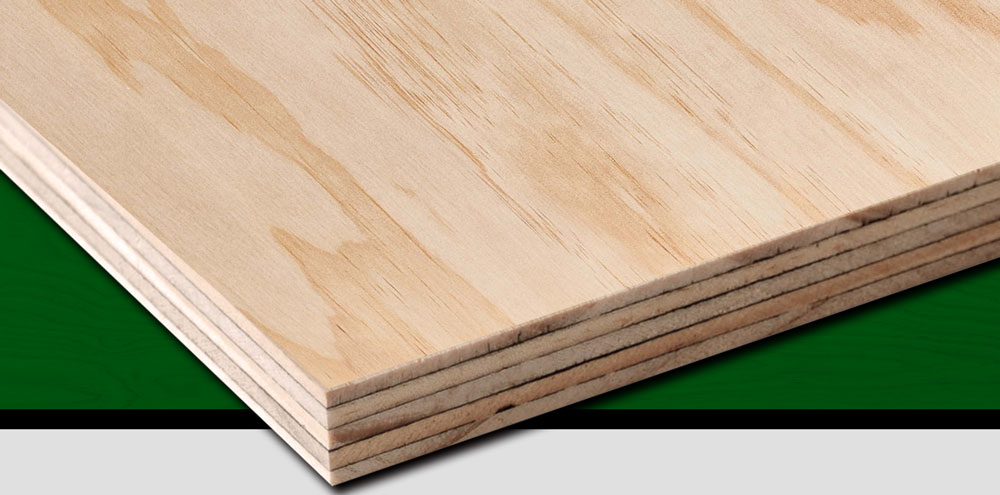
Why many timber whosaler stay with ROCPLEX
They like steady sheets and calm service. They also like clear files. Our plywood factory teams answer fast. Our export staff book space early. We keep your brand mark if you need white label. ROCPLEX do not chase one-off wins, build long flows. That is how margins stay safe.
Smart next steps
1) Pick one project as a pilot.
2) Map the spec with our team.
3) Set a load plan and schedule.
4) Track yield and hours saved.
5) Review together. Then scale.
ROCPLEX will help at each step. We bring mill facts and clear math. Your team keeps control and speed, clients get clean work. Your business keeps its edge.
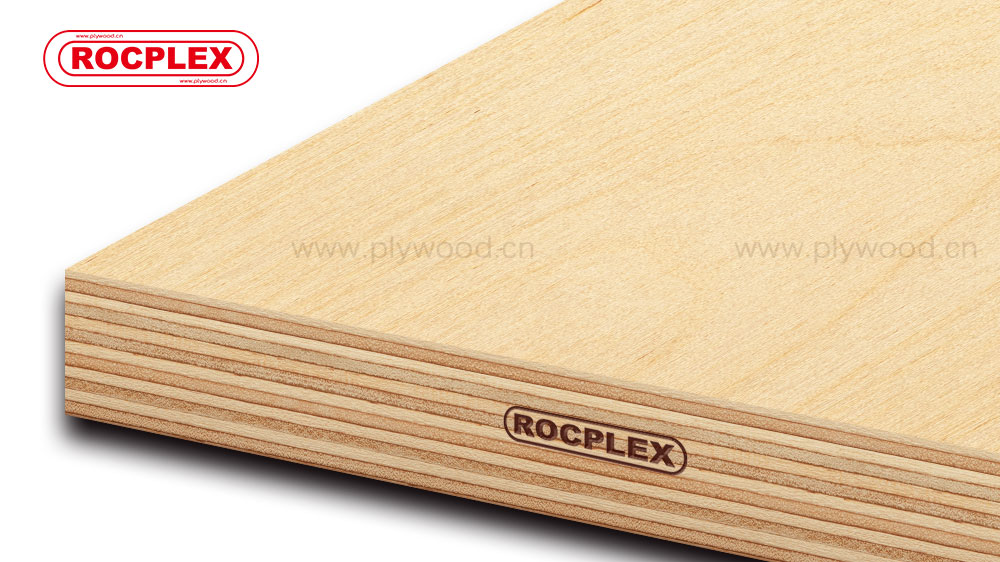
100% Full Birch Plywood
ROCPLEX Full Birch Plywood is crafted using 100% high-grade birch veneers. This plywood features uniform density, smooth surfaces, and strong core bonding. The material is ideal for demanding uses such as cabinetry, interior fittings, and precision machining. Full Birch Plywood from ROCPLEX is known for its stability and screw-holding strength. It provides consistency across sheets and performs well under mechanical stress. ROCPLEX ensures reliable supply and consistent product quality across markets.
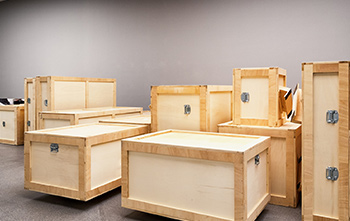
Packing Plywood
What is Packing Plywood?
Shippers use thin yet tough packing plywood panels to build crates, pallets, and box skins. These panels balance strength, weight, and cost for land, sea, and air paths. Mills lay veneers in cross grain, then press them with moisture-rated glue. The cross lay stops warp and spreads impact across the sheet. Good boards take nails without split and hold screws well. Edges stay firm with proper sealing. The right sheet protects corners and faces from dents. It also stacks flat to save space in the yard. You get steady quality when mills follow a clear grading plan and strict checks.
Packing Plywood Grades, Cores, and Glue Options
Select by route, cargo risk, and budget. Use eucalyptus or poplar cores for value. Choose mixed hardwood when you need extra bite. Urea glue fits dry inland moves. MR glue handles humid zones. E1 and CARB options support air freight rules. Film-free faces keep price low. You can add PE tape on edges for wet yards.
Packing Plywood Specifications and Sizes
We cut common sizes for crate walls and decks. Typical sheets include 1220 × 2440 in 6–18 mm. You can order 1000 × 2000 for small kits. Face grades run C/C or C/D for value. Sanded faces speed printing and marking. Tight thickness control keeps crate fit exact. We brand pallets on request for fast ID in hubs.
Packing Plywood Performance in Crates, Pallets, and Boxes
Boards need shear strength, not just bend strength. Cross grain layers deliver shear control at joints. Nail heads seat flush with low chip-out. The panel spreads load to bearers and blocks. Fork pockets see less crush with sealed edges. Crews repair panels in minutes at site. That keeps lines moving when time is short.
Packing Plywood vs OSB and MDF
OSB offers stiffness for floors, yet edges swell faster in wet yards. MDF prints well, but it chips with nails and screws. Plywood bridges both needs with better fastener hold and lower weight. It also handles knocks in transit better. You save on rework and claim risk.
Packing Plywood Sourcing, Price, and MOQ Guidance
Costs change with veneer yield, glue type, and fiber mix. Thinner sheets save weight on air and courier lines. Thicker decks cut pallet count by carrying more per stack. Book mixed thickness in one container to balance stock. Confirm the wood species to match fastener pull. Ask for stable monthly price bands to plan bids.
Packing Plywood Quality Control and Compliance
We grade veneers, check moisture, and align cores before layup. Hot-press cycles follow tight time and heat curves. Calipers and micrometers check thickness at many points. Edge seal locks out yard splash. Labels show batch, press time, and shift. You can trace each crate kit to a run. Formaldehyde limits meet E1 or CARB rules on request.
Packing Plywood Applications and Industries
Electronics makers use light panels for air cargo kits. Auto parts ship in returnable crates with screw-out walls. Furniture brands rely on neat faces for print and logos. Agri exporters want quick-dry boards after wash down. 3PL hubs keep mixed sizes for rush builds. Industrial plywood sheets work well for heavy gear skids.
Packing Plywood Sizing and Conversion Tips
Plan sheet yield from crate cut lists. Use 2440 × 1220 to pull two 1200 × 1000 walls with minimal waste. For pallets, map deck boards to bearer spacing. Keep openings clear for forks and clamps. Choose 9–12 mm walls for light goods. Step to 15–18 mm for heavy motors. Mark nail zones to prevent split.
Packing Plywood Handling, Storage, and Safety
Stack on flat bearers and cover the top. Keep packs off wet ground. Rotate stock with clear tags. Lift with spreader bars to avoid dent marks. Crews should glove up when cutting. Use sharp blades for clean edges. Vent cutting bays to control dust. Dispose of offcuts per local rules.
Packing Grade PlywoodCost Reduction Without Risk
Drop face grade, not core quality, for inside surfaces. Reduce thickness one step when cargo density is low. Switch to MR glue for inland routes. Optimize kit sizes to match standard sheets. Bundle hardware with each kit to stop delays on site. Control waste with templated cut plans.
Buying Checklist
-
Confirm cargo weight and route.
-
Fix thickness per wall, deck, and lid.
-
Set glue and emissions class.
-
Approve sample with edge seal.
-
Check pallet jack clearances.
-
Print shipping marks and QR codes.
-
Lock packing list and kit map.
-
Align delivery to build date.
Lead Times and Logistics
Stock items ship fast from the yard. Custom cuts need set press slots. Allow time for drying in wet seasons. We book space early on peak lanes. Mixed loads cut overall freight cost. Export paperwork follows the order plan.
Packing Plywood FAQs
What thickness should I use for crate walls?
Choose 9–12 mm for light goods. Use 15–18 mm for heavy or tall stacks.
How do I reduce weight for air freight?
Pick lightweight plywood and tighter crate frames. Keep spans short between supports.
Can I print logos on the sheets?
Yes. Sanded faces take ink well. We also supply stencils and paint.
How do I prevent edge crush in rain?
Seal edges and store on bearers. Load quickly after arrival at yard.
Post time: Oct-06-2025

